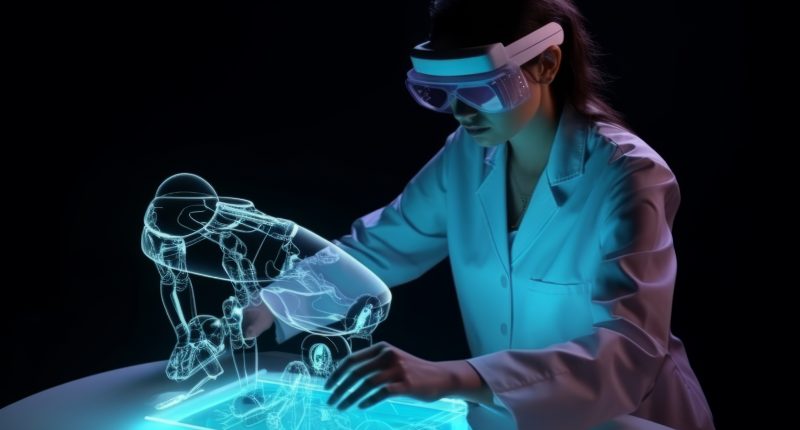### Introduction
Recent advancements in the field of bioimaging have led to the emergence of innovative technologies, one of which is the two-photon clusteroluminescence bioimaging (TPCL bioim). The study conducted by Jianyu Zhang and colleagues explores this frontier by developing a novel approach to enhance clusteroluminescence efficiency through through-space conjugation (TSC). Traditional clusteroluminescence materials, while promising due to their unique photophysical behaviors, have been restricted by their low luminescence efficiencies and limited emission wavelengths. By infusing diarylmethane with n-electron involvement, the researchers have crafted three distinct luminogens that not only exhibit single-photon excited long-wavelength emissions at 688 nm but also demonstrate high-efficiency (29%) clusteroluminescence.
The crucial innovation in this research lies in the application of through-space conjugation, which effectively stabilizes electrons in aggregated states, thereby enabling efficient spatial delocalization of electrons akin to those seen in traditional conjugated compounds. This structural manipulation allows these small luminogens, equipped with only two isolated heteroatomic units, to achieve remarkable two-photon clusteroluminescence. The practical implications of these findings are significant, facilitating two-photon imaging of blood vessels in vivo, alongside verifying the biocompatibility of the luminogens used. This paper not only underscores the role of TSC in enhancing nonlinear optical properties but also paves the way for the advancement of next-generation bioprobes that promise improved biocompatibility and bioimaging capabilities.
### Background and Context
The innovative research carried out by Jianyu Zhang and his team builds upon the principles of clusteroluminescence—a phenomenon wherein non-conventional luminescent materials emit light without the presence of conventional chromophores. This type of luminescence is particularly attractive for biological applications because of its potential for bioimaging due to the absence of heavy metals and reduced photobleaching. With the development of two-photon clusteroluminescence bioimaging (TPCL bioim), there is a growing interest in enhancing these materials for practical medical and scientific uses.
Historically, clusteroluminescence has faced challenges primarily due to low quantum yields and narrow emission spectra. These limitations have impeded the broader application of clusteroluminescent compounds in clinical and research settings, where high efficiency and broader spectral coverage are generally required. Two-photon excitation microscopy, known for its ability to enable deeper tissue penetration and reduced phototoxicity, has been seen as an ideal candidate for overcoming these challenges. By using longer wavelengths, two-photon excitation minimizes scattering and absorption in biological tissues, which extends the imaging depth and improves the overall clarity of the acquired images.
The work of Zhang et al. takes these fundamentals to the next level through the introduction of through-space conjugation (TSC). This innovative design principle leverages the spatial orientation of molecules to achieve electron delocalization effects similar to those in pi-conjugated systems but without the need for extensive double-bond networks. This structural arrangement effectively optimizes the luminescence properties by facilitating enhanced photon absorption and efficient electron stabilization, thus leading to higher emission efficiencies.
In the context of their research, the construction of diarylmethane derivatives with n-electron configuration significantly advances the scope of TPCL bioim. These molecules are uniquely poised to address the spectral limitations of traditional clusteroluminescent compounds by offering long-wavelength emissions. This property is particularly beneficial for biological tissues where absorption and auto-fluorescence are reduced at longer wavelengths, thereby ensuring clearer and more precise imaging capabilities.
Moreover, the practical demonstration of TPCL bioim in the imaging of blood vessels in vivo provides compelling evidence of the method’s applicability and effectiveness. The researchers’ ability to image the vasculature with such clarity underlines the potential of this novel TPCL bioim platform in enhancing the resolution and depth of bioimaging practices.
By leveraging the merits of through-space conjugation and two-photon excitation, the researchers’ advancement in clusteroluminescence technology not only paves the way for the development of advanced bioimaging methodologies but also strengthens the foundation for further innovations in the field. The creation of efficient, biocompatible luminogens highlights a significant step forward in the quest for safer, more effective imaging tools, making two-photon clusteroluminescence bioim a promising candidate for future biomedical research and clinical diagnostics.
### Methodology
In their pioneering research into two-photon clusteroluminescence bioimaging (TPCL bioim), Jianyu Zhang and his team employed a multifaceted approach to synthesize and evaluate a series of novel diarylmethane-based luminogens. Their methodology is detailed in several key stages: synthesis of luminogens, characterization of their photophysical properties, and biological application and imaging efficacy.
#### Synthesis of Diarylmethane Derivatives
The initial phase involved the synthesis of three distinct diarylmethane derivatives designed to incorporate n-electron systems through a strategic through-space conjugation method. This innovative synthetic route focused on integrating isolated heteroatomic units within a single molecule to facilitate electron delocalization akin to pi-conjugation, albeit through non-conventional means. The choice of diarylmethane as the core structure was crucial, given its potential to form stable clustered arrangements necessary for clusteroluminescence.
#### Photophysical Characterization
Following synthesis, the luminogens underwent rigorous photophysical characterization to determine their emission properties and quantum yields. The team utilized both single-photon and two-photon excitation methods to comprehensively evaluate the efficiency of clusteroluminescence. Single-photon excitation was performed using a standard fluorescence spectrometer, while the two-photon absorption properties were assessed using a femtosecond pulsed laser, which is ideal for observing the effects of nonlinear optical phenomena inherent in TPCL bioim. This step was critical in establishing the luminogens’ potential for deep tissue imaging, with a particular focus on their long-wavelength emission capabilities and high-efficiency performance.
#### Biological Application: In Vivo Imaging of Blood Vessels
The practical application of the synthesized luminogens was demonstrated through in vivo imaging of blood vessels, showcasing the real-world utility of two-photon clusteroluminescence bioimaging. The researchers injected the luminogens into the bloodstream of a small animal model and used a two-photon microscope equipped with a near-infrared (NIR) laser to excite the luminogens. This approach enabled the visualization of blood vessels deep within the tissue, highlighting the compounds’ ability to produce clear and detailed images under physiological conditions.
#### Evaluation of Biocompatibility
Complementing the imaging studies was an assessment of the biocompatibility of the newly developed luminogens. The team performed cytotoxicity tests and verified that the compounds were not toxic to the biological tissues, an essential factor for their use in clinical settings. This evaluation was critical in confirming that the advances in TPCL bioim technology do not compromise the safety of biological subjects.
Throughout their research into two-photon clusteroluminescence bioim, Jianyu Zhang and his colleagues successfully navigated the challenges of creating highly efficient and biocompatible luminogens suitable for advanced bioimaging applications. Their methodological rigor and innovative approach in synthesizing and testing these novel compounds underscore the potential for further advancements in the field of biomedical imaging.
### Key Findings and Results
The research carried out by Jianyu Zhang and his team on two-photon clusteroluminescence bioim (TPCL bioim) has produced several groundbreaking findings that significantly advance the field of bioimaging. The introduction of through-space conjugation (TSC) in the design of novel diarylmethane derivatives is central to these developments, offering enhanced clusteroluminescence properties that are optimized for practical applications in biomedical imaging.
#### Enhanced Clusteroluminescence Efficiency
One of the pivotal results of this study is the realization of enhanced clusteroluminescence efficiency in the diarylmethane derivatives. The researchers successfully synthesized three distinct luminogens that demonstrated high quantum yields of 29%, a remarkable improvement over traditional clusteroluminescent materials. This increased efficiency is attributed to the through-space conjugation mechanism, which facilitates better spatial delocalization of electrons, mimicking the effects typically seen in pi-conjugated systems but achieved through non-traditional means. This innovative approach results in significant luminogenic activity within clusteroluminescent materials, setting a new benchmark in their efficiency.
#### Single-Photon and Two-Photon Excited Long-Wavelength Emissions
A key finding from the photophysical characterization is that these luminogens exhibit long-wavelength emissions at 688 nm when excited by a single photon. What makes this feature particularly significant is that long-wavelength emissions are capable of penetrating deeper into biological tissues with minimal absorption and scattering. Furthermore, in the realm of two-photon clusteroluminescence bioim, these materials showed remarkable properties under two-photon excitation. This is crucial because two-photon excitation allows for greater depth of tissue imaging, making it invaluable in medical diagnostic procedures and research involving thick biological specimens.
#### In Vivo Imaging Capabilities
The practical application of these novel luminogens was exemplarily demonstrated through the in vivo imaging of blood vessels. This experiment highlighted the real-world potential of TPCL bioim in providing crystal-clear images of biological structures deep within tissues. Using two-photon microscopy, the researchers were able to excite the luminogens within the blood vessels of a living animal model, achieving detailed visualization at depths not feasible with traditional fluorescence imaging techniques. This capability could revolutionize diagnostic procedures, particularly in areas requiring precise imaging like neurology or oncologic studies.
#### Biocompatibility
An equally important outcome of this research is the verification of the biocompatibility of the novel luminogens. Through meticulous cytotoxicity testing, the team established that these materials are safe for use in biological systems. This aspect is critical, given that any advancement in bioimaging should not come at the cost of safety. The biocompatibility of these luminogens ensures that the advancements in TPCL bioim can be translated into clinical settings without adverse effects on patient health.
In conclusion, the research on two-photon clusteroluminescence bioim conducted by Jianyu Zhang and his team marks a significant leap forward in the capabilities of bioimaging technologies. By addressing and overcoming the limitations of traditional clusteroluminescent materials through innovative chemical design and photophysical properties, this study not only expands the potential applications of TPCL bioim but also sets a new standard for future research and development in advanced biomedical imaging solutions. These advancements hold great promise for enhancing the diagnostic and therapeutic capabilities in healthcare, providing deeper insights into biological processes at the cellular and molecular levels.
### Future Directions and Final Thoughts
The groundbreaking study on two-photon clusteroluminescence bioimaging (TPCL bioim) conducted by Jianyu Zhang and his team opens several avenues for further research and development in the field of biomedical imaging. Future studies are expected to focus on refining and diversifying the applications of TPCL bioim technology, harnessing its unique capabilities for more specialized medical and scientific contexts.
One of the promising future directions is the exploration of additional molecular structures that could further harness the potential of through-space conjugation. Researchers could design a variety of new luminogens that operate at different wavelengths or offer varying degrees of photostability and quantum yield. This would cater to a broader range of biophotonic applications, making TPCL bioim even more versatile in the medical field.
Another intriguing path would be integrating TPCL bioim technology with other imaging modalities, such as magnetic resonance imaging (MRI) or computed tomography (CT), to create multifunctional imaging tools. Such hybrid systems could potentially provide more comprehensive diagnostic information by combining the strengths of each imaging technique, thus opening new strategic pathways in precision medicine.
In the academic sphere, additional focus could be laid on studying the long-term effects and interactions of clusteroluminescent materials within biological systems at the molecular level. Understanding these interactions further would help in modifying the materials for even safer and more effective use in clinical environments. Additionally, expanding the scale of animal studies and transitioning to human clinical trials would be crucial to fully establish the clinical viability of these luminogens.
Moreover, efforts to make the synthesis of these novel compounds more environmentally friendly and economically viable would address scalability and sustainability concerns, making TPCL bioim technology more accessible for widespread medical use. The potential for personalized medicine, where TPCL bioim could be tailored to individual patient diagnostics and treatment planning, also presents an exciting frontier for both research and application.
The implications of such advancements might redefine the standards of care in oncology, neurology, and cardiology, providing physicians with powerful tools for early diagnosis, precise surgical navigation, and effective monitoring of treatment responses.
In conclusion, the tale of two-photon clusteroluminescence bioimagic illustrates not just a scientific breakthrough but a beacon that could guide the future of medical imaging towards unprecedented precision and safety. The work of Jianyu Zhang and his team is not merely a step but a leap into the future, where the insights provided by such advanced technologies would substantially elevate the capabilities of medical practice. The continued exploration and enhancement of two-photon clusteroluminescence bioim promise to revolutionize our understanding and interaction with the most intricate biological systems, ideally blending scientific curiosity with clinical efficacy in the ever-evolving landscape of healthcare.
Related Articles:
– [[Ⅰ. Evaluation of Disease Burden of HPV-Related Head and Neck Cancer in Japan].](https://www.arkridgesciences.com/%e2%85%b0-evaluation-of-disease-burden-of-hpv-related-head-and-neck-cancer-in-japan/)
– [Moving Beyond the Temporal Bone Lab: Creating a Drilling Station in the Otolaryngology Clinic.](https://www.arkridgesciences.com/moving-beyond-the-temporal-bone-lab-creating-a-drilling-station-in-the-otolaryngology-clinic/)
– [Borax induces ferroptosis of glioblastoma by targeting HSPA5/NRF2/GPx4/GSH pathways.](https://www.arkridgesciences.com/borax-induces-ferroptosis-of-glioblastoma-by-targeting-hspa5-nrf2-gpx4-gsh-pathways/)









